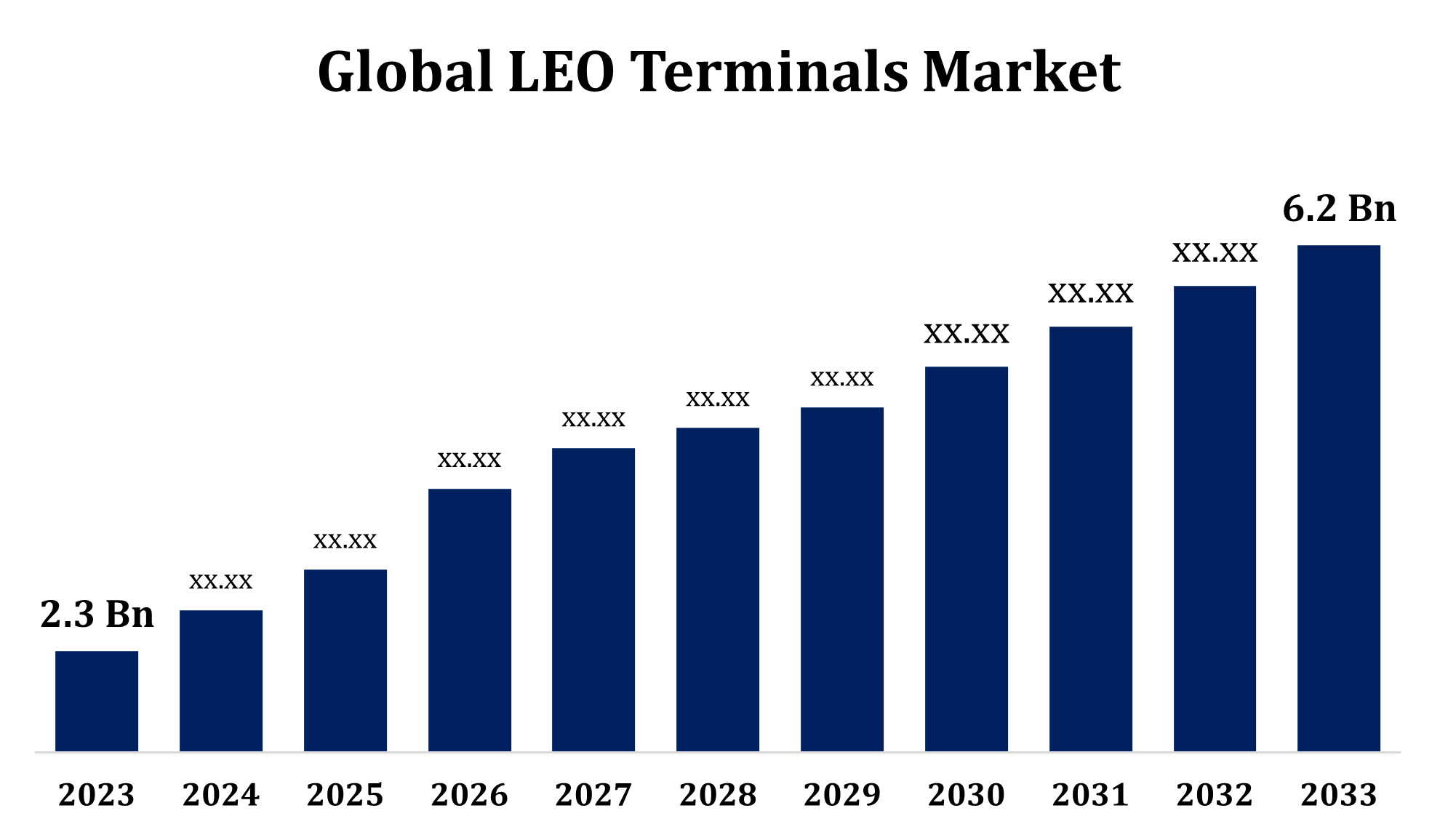Global LEO Terminals Market Size To Worth USD 6.2 Billion By 2033 | CAGR of 10.42%
Category: Aerospace & DefenseGlobal LEO Terminals Market Size To Worth USD 6.2 Billion By 2033
According to a research report published by Spherical Insights & Consulting, the Global LEO Terminals Market Size to Grow from USD 2.3 Billion in 2023 to USD 6.2 Billion by 2033, at a Compound Annual Growth Rate (CAGR) of 10.42% during the forecast period.

Get more details on this report -
Browse key industry insights spread across 259 pages with 121 Market data tables and figures & charts from the report on the "Global LEO Terminals Market Size, Share, and COVID-19 Impact Analysis, By Application (Satellite Communication, Internet of Things, Remote Sensing), By Terminal Type (Mobile Terminals, Fixed Terminals, Transportable Terminals), By Technology (Software Defined Networking, Cloud Computing, Artificial Intelligence), and By Region (North America, Europe, Asia-Pacific, Latin America, Middle East, and Africa), Analysis and Forecast 2023 - 2033." Get Detailed Report Description Here: https://www.sphericalinsights.com/reports/leo-terminals-market
The Low Earth Orbit (LEO) terminals market is expanding rapidly, driven by the growing need for fast, reliable, and low-latency satellite communication. Positioned closer to Earth, LEO satellites offer improved data transmission and global coverage, making them ideal for uses like broadband internet, remote sensing, and communication in maritime or aviation sectors. Technological innovations have led to the creation of smaller, cost-effective terminals, boosting adoption across multiple industries. The market is further supported by increased investments from both private companies and government initiatives focused on enhancing connectivity in underserved and remote regions. Key industries such as defense, telecommunications, and transportation are utilizing LEO terminals for efficient communication. With the expansion of satellite constellations, the market is poised for significant growth in the years ahead.
LEO Terminals Market Value Chain Analysis
The value chain of the Low Earth Orbit (LEO) terminals market includes several critical stages, starting from raw material supply to service delivery. Initially, raw material suppliers provide essential components such as semiconductors, antennas, and advanced composites. Satellite and terminal manufacturers then design and create hardware tailored to LEO specifications, emphasizing compactness, durability, and high performance. Network integrators and ground station operators facilitate the connection between satellites and terminals, ensuring seamless data transmission and network stability. The final step involves service providers offering end-user solutions like broadband internet, IoT services, and communication. Collaboration among private companies, government agencies, and technology providers is crucial for driving innovation and market growth. Ongoing research and development, along with infrastructure investments, are key to enhancing efficiency throughout the value chain.
LEO Terminals Market Opportunity Analysis
The Low Earth Orbit (LEO) terminals market offers considerable growth potential, fueled by the increasing demand for high-speed, low-latency connectivity worldwide. Expanding satellite constellations from companies like SpaceX, OneWeb, and Amazon’s Project Kuiper are driving the need for advanced, cost-efficient terminals. A strong emphasis on bridging the digital divide, particularly in remote and underserved areas, is another key factor propelling market growth. Sectors such as defense, maritime, aviation, and telecommunications are adopting LEO terminals to ensure reliable global coverage and uninterrupted communication. Furthermore, the growing integration of LEO terminals with IoT and smart applications unlocks new opportunities for innovation. Government initiatives and private investments in space technology further enhance these prospects, positioning the LEO terminals market for significant expansion in the coming years.
The increasing demand for high-speed internet access is a primary factor driving the growth of the Low Earth Orbit (LEO) terminals market. Positioned closer to Earth, LEO satellites offer faster data transmission and reduced latency compared to traditional geostationary systems, making them ideal for addressing the rising need for connectivity. This is particularly vital in remote and underserved regions where terrestrial infrastructure is scarce or unavailable. The expansion of satellite constellations by companies like SpaceX and OneWeb has further fueled the demand for efficient and affordable LEO terminals to support broadband services. Moreover, industries such as maritime, aviation, and defense are turning to LEO terminals for reliable communication. As digital transformation accelerates and the demand for internet connectivity increases, the LEO terminals market is set for substantial growth.
A key challenge in the Low Earth Orbit (LEO) terminals market is the high cost associated with developing and deploying advanced terminals, which can limit access for price-sensitive markets. Technical challenges, such as maintaining seamless connectivity with fast-moving LEO satellites and minimizing signal interference, add complexity. Scalability is also a concern, as the growing number of satellites could lead to congestion, requiring efficient network management. Regulatory hurdles, including spectrum allocation and international compliance, complicate market operations further. Additionally, intense competition among satellite operators and terminal manufacturers puts pressure on pricing, affecting profitability. Environmental issues, such as space debris from the expanding number of satellites, also raise sustainability concerns. Overcoming these challenges is critical to realizing the full potential of the LEO terminals market.
Insights by Application
The Satellite Communication segment accounted for the largest market share over the forecast period 2023 to 2033. The growth of the satellite communication segment in the Low Earth Orbit (LEO) terminals market is driven by the increasing demand for global connectivity and high-speed internet services. LEO satellites, which are closer to Earth, provide lower latency and faster data transmission than traditional geostationary satellites, making them ideal for real-time communication, particularly in remote and rural regions. The expansion of global satellite constellations from companies such as SpaceX, OneWeb, and Amazon’s Project Kuiper is enhancing network coverage and driving adoption. Applications like broadband internet, voice communication, and IoT services are gaining traction in industries such as telecommunications, aviation, and maritime. With a growing emphasis on improving digital infrastructure and bridging the connectivity gap, the satellite communication segment is poised for sustained growth in the LEO terminals market.
Insights by Terminal Type
The mobile terminals segment accounted for the largest market share over the forecast period 2023 to 2033. LEO satellites, known for their low latency and high-speed data transmission, are well-suited for mobile communication applications, such as mobile broadband and satellite-enabled services in remote or underserved regions. As mobile network providers look for alternatives to traditional terrestrial infrastructure, LEO terminals provide an efficient solution for extending coverage to hard-to-reach areas. The integration of LEO terminals into smartphones, vehicles, and wearable devices is enhancing mobile connectivity and supporting industries such as automotive, aviation, and logistics. With ongoing advancements in satellite constellations by key players like SpaceX and OneWeb, the mobile terminals segment is poised for rapid growth, significantly transforming the global mobile communication landscape.
Insights by Technology
The Software Defined Networking segment accounted for the largest market share over the forecast period 2023 to 2033. The Software Defined Networking (SDN) segment is experiencing significant growth in the Low Earth Orbit (LEO) terminals market, as it provides flexible, efficient, and scalable network management for satellite communication. SDN facilitates dynamic configuration and optimization of LEO satellite networks, improving traffic management, performance, and reducing latency. As the number of LEO satellite constellations increases, SDN offers a centralized method to control network traffic, ensuring smooth integration and communication between satellites, ground stations, and terminals. This technology is especially valuable for managing complex data flows in global networks. With rising demand for broadband services, IoT applications, and real-time communications, SDN is crucial for optimizing satellite network operations and delivering reliable service. The SDN segment in LEO terminals is expected to grow rapidly with the deployment of more advanced satellite constellations.
Insights by Region

Get more details on this report -
North America is anticipated to dominate the LEO Terminals Market from 2023 to 2033. North America is home to major players such as SpaceX, Amazon’s Project Kuiper, and OneWeb, all of which are actively expanding their LEO satellite constellations. The increasing adoption of LEO terminals across sectors like defense, aviation, maritime, and rural broadband services is driving further market growth. Government initiatives, including NASA and U.S. Department of Defense projects, are advancing LEO technologies. Moreover, the region’s focus on closing the digital divide in underserved and remote areas is boosting demand for LEO terminals. With strong innovation and effective public-private collaboration, North America remains a leader in the global LEO terminals market.
Asia Pacific is witnessing the fastest market growth between 2023 to 2033. The growth of the LEO terminals market in Asia-Pacific is driven by the increasing demand for high-speed internet connectivity in both densely populated urban areas and underserved rural regions. Governments are making substantial investments in satellite communication technologies to improve digital infrastructure and address connectivity issues. The emergence of private players and collaborations with global LEO satellite operators like OneWeb and SpaceX is further fueling market expansion. Key industries, including maritime, agriculture, and defense, are adopting LEO terminals for efficient and reliable communication. Moreover, initiatives aimed at bridging the digital divide and supporting smart city development are contributing to the rising demand. With rapid economic growth and technological progress, Asia-Pacific is set to become a major player in the LEO terminals market.
Recent Market Developments
- In August 2023, Hughes Network Systems, an EchoStar subsidiary, has secured a five-year Indefinite Delivery Indefinite Quantity (IDIQ) contract with the US Space Force. This contract allows the US Department of Defense, federal agencies, and international coalition partners to access Hughes' fully managed, low-latency satellite services powered by Low Earth Orbit (LEO) technology.
Major players in the market
- Hewlett Packard Enterprise
- Rockwell Collins
- Airbus Defence and Space
- Inmarsat
- SES S.A.
- Sawyer Aerospace
- Orbit Communications Systems
- Lockheed Martin
- L3Harris Technologies
- Northrop Grumman
- Boeing
- Ball Aerospace
- Iridium Communications
- Thales Group
- Cubic Corporation
Market Segmentation
This study forecasts revenue at global, regional, and country levels from 2023 to 2033.
LEO Terminals Market, Application Analysis
- Satellite Communication
- Internet of Things
- Remote Sensing
LEO Terminals Market, Terminal Type Analysis
- Mobile Terminals
- Fixed Terminals
- Transportable Terminals
LEO Terminals Market, Technology Analysis
- Software Defined Networking
- Cloud Computing
- Artificial Intelligence
LEO Terminals Market, Regional Analysis
- North America
- US
- Canada
- Mexico
- Europe
- Germany
- Uk
- France
- Italy
- Spain
- Russia
- Rest of Europe
- Asia Pacific
- China
- Japan
- India
- South Korea
- Australia
- Rest of Asia Pacific
- South America
- Brazil
- Argentina
- Rest of South America
- Middle East & Africa
- UAE
- Saudi Arabia
- Qatar
- South Africa
- Rest of the Middle East & Africa
About the Spherical Insights & Consulting
Spherical Insights & Consulting is a market research and consulting firm which provides actionable market research study, quantitative forecasting and trends analysis provides forward-looking insight especially designed for decision makers and aids ROI.
Which is catering to different industry such as financial sectors, industrial sectors, government organizations, universities, non-profits and corporations. The company's mission is to work with businesses to achieve business objectives and maintain strategic improvements.
CONTACT US:
For More Information on Your Target Market, Please Contact Us Below:
Phone: +1 303 800 4326 (the U.S.)
Phone: +91 90289 24100 (APAC)
Email: inquiry@sphericalinsights.com, sales@sphericalinsights.com
Contact Us: https://www.sphericalinsights.com/contact-us
Need help to buy this report?